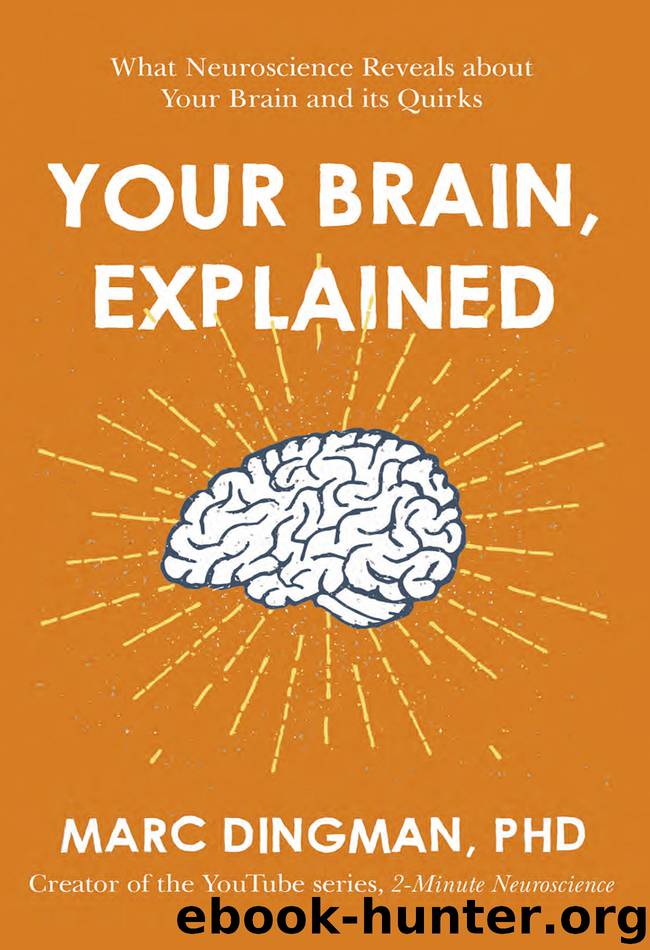Your Brain, Explained by Marc Dingman

Author:Marc Dingman
Language: eng
Format: epub
Publisher: Quercus
Published: 2019-10-01T16:00:00+00:00
The motor homunculus. The motor cortex is the large, gray area. Images of body parts are situated over the regions of the motor cortex thought to control them. The body parts are distorted to indicate the relative area of motor cortex devoted to them (e.g., there is more motor cortex assigned to the hand than to the foot).
The motor cortex in action
Even before the motor cortex had been fully mapped out, many of the pathways that travel from it to allow the brain to control movement had already been identified. The largest of these pathways starts with cells in the motor cortex, which then send axons down through the brain and into the spinal cord. Because it follows this path (from the cortex to the spinal cord), it’s known as the corticospinal tract.
The neurons in the spinal cord that the corticospinal tract communicate with then travel out to the muscles in the body to cause them to contract. Interestingly, the signal that activates a muscle on one side of your body usually comes from the other side of your brain. This is because most of the axons of the corticospinal tract cross over from one side of the brain to the other when they reach the brainstem. Then, they travel down to the body on the opposite side from where they originated.
There are clinical applications of this crossing over, which is technically known as decussation. For example, if someone is admitted to the emergency room with symptoms like headache, blurred vision, confusion, and an inability to move the muscles on the left side of the body, a doctor would likely assume they’re suffering from a stroke that’s primarily affecting the right side of their brain. This, of course, is because the neurons in the corticospinal tract that control the movement of the left side of the body start in the right cerebral hemisphere.
Download
This site does not store any files on its server. We only index and link to content provided by other sites. Please contact the content providers to delete copyright contents if any and email us, we'll remove relevant links or contents immediately.
Periodization Training for Sports by Tudor Bompa(8170)
Why We Sleep: Unlocking the Power of Sleep and Dreams by Matthew Walker(6618)
Paper Towns by Green John(5091)
The Immortal Life of Henrietta Lacks by Rebecca Skloot(4526)
The Sports Rules Book by Human Kinetics(4294)
Dynamic Alignment Through Imagery by Eric Franklin(4118)
ACSM's Complete Guide to Fitness & Health by ACSM(3989)
Kaplan MCAT Organic Chemistry Review: Created for MCAT 2015 (Kaplan Test Prep) by Kaplan(3940)
Introduction to Kinesiology by Shirl J. Hoffman(3726)
Livewired by David Eagleman(3684)
The Death of the Heart by Elizabeth Bowen(3552)
The River of Consciousness by Oliver Sacks(3541)
Alchemy and Alchemists by C. J. S. Thompson(3451)
Bad Pharma by Ben Goldacre(3357)
Descartes' Error by Antonio Damasio(3230)
The Emperor of All Maladies: A Biography of Cancer by Siddhartha Mukherjee(3068)
The Gene: An Intimate History by Siddhartha Mukherjee(3048)
The Fate of Rome: Climate, Disease, and the End of an Empire (The Princeton History of the Ancient World) by Kyle Harper(3003)
Kaplan MCAT Behavioral Sciences Review: Created for MCAT 2015 (Kaplan Test Prep) by Kaplan(2940)
